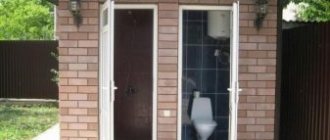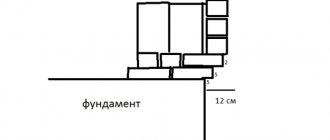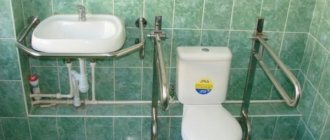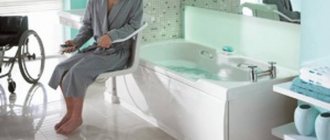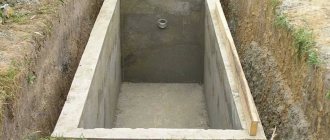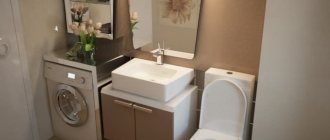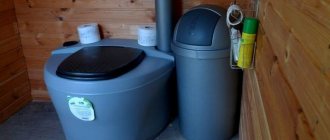mark_kr
31266 0 4
mark_kr August 2, 2016Specialization: professional in the field of construction and repair (full cycle of finishing work, both internal and external, from sewerage to electrical and finishing work), installation of window structures. Hobbies: see the column “SPECIALIZATION AND SKILLS”
There are several ways to ensure comfort when visiting “places of solitude”
A warm toilet and sewerage system in a village house is the dream of every summer resident. And this is quite understandable: if a person has ever run out in the rain into a wooden structure standing near a fence, then he will definitely appreciate the benefits of a bathroom located in the house itself.
In principle, arranging a toilet is not one of the most difficult tasks. Having studied specialized literature and developed a suitable project, it is quite possible to implement it yourself. Of course, you will have to work hard, but you can definitely do it in one season.
Calculation of bathrooms for a public building
Size, whatever one may say, matters... especially when it comes to what the size of the bathroom should be.
The legislation of all countries has clear standards regulating the area of the bathroom and toilet. In this article we will tell you what standard bathroom sizes exist, discuss the minimum possible dimensions, and tell you how to correctly determine the area of the sanitary room in your future home.
Dimensions – SNiP and DIN
The current technical regulations, reflected in SNiP and DIN 18022, clearly define the dimensions of a bathroom for residential premises:
- minimum floor/ceiling height – 2500 mm;
- depth – not less than 1200 mm;
- in the attic, the distance from the toilet to the roof slope is 1050 mm;
- The minimum width of the bathroom is 800 mm.
Important: Doors must open exclusively outward, and exit only to the hallway and corridor, living rooms and kitchen; exit from the bathroom and toilet is prohibited. The height of the ceilings in the corridor at the exit should not be less than 2100 mm. . SNiP also regulates the standard dimensions of a bathroom, a combined toilet with a bathtub, and the installation of plumbing fixtures in it:
SNiP also regulates the standard dimensions of a bathroom, a combined toilet with a bathtub, and the installation of plumbing fixtures in it:
- there must be at least 700 mm of free space in front of the bathtub and shower, and 600 mm of free space in front of the toilet;
- the bidet is installed 250 mm from the toilet, unless otherwise provided by the model;
- There should be 250 mm of free space on the sides of the plumbing point.
Reminder about plumbing placement standards
Typical bathrooms in residential buildings
The standard sizes of toilets in standard apartment buildings are 1200 * 800 mm, 1500 * 800 mm, and with an improved layout - 100 * 1500 mm, which can accommodate a sink or a narrow washing machine.
Minimum bathroom sizes allowed during the construction of standard multi-apartment residential buildings
As for the bathroom, its average size is 1650-2000 * 1200-2500 m. The combined room in Khrushchev is 3.3 - 3.8 m2.
Standard sizes with ergonomic layout (sheet 1)
In new economy class buildings, restrooms are already somewhat larger - from 4 sq.m., and in improved series of houses there are rooms of 5-6 sq.m. m. In luxury apartments, the area is rarely less than 7 sq.m. The optimal size of a bathroom in a private house is from 9 sq.m. Here you can already organize a full-fledged oasis of relaxation.
Standard rooms with ergonomic layout (sheet 2)
Minimal bathroom
The smallest restrooms measure 1.8-2.0 square meters. found in small apartments. But even such areas can be decorated with proper comfort.
The photo shows a small bathroom 1800*1200 mm with a shower (before and after renovation)
Of course, you will have to give up the bathtub in favor of a cheap cabin or panel, but with the correct arrangement of plumbing, you can fit even a narrow washing machine.
Narrow mini bathroom, dimensions 1700*1200 m, single material for floor and walls optically expands the boundaries of the room
Photo of a shared small bathroom
How to choose a size
When it becomes possible to independently set the size of the bathroom without any restrictions on space, many people who have had their fill of narrow and cramped standard rooms begin to dream of a large space where they do not have to save every centimeter. Let’s make a reservation right away: a huge bathroom is a complete waste, so here you need to look for a middle ground.
If you follow the laws of ergonomics, then an area of 1.7-2.5 square meters is required for a shower stall, 2.7-3.5 square meters for a comfortable bath, and 1.2-1.8 square meters for a toilet. for a sink is about 1 m. Thus, the optimal area of a restroom for a family of 4-6 people is 7-9 sq. m. It is better if it is a rectangular room: the width of the bathroom is 2.5 m and the length is 3.5 m.
For proper bathroom planning, it is useful to know:
- height of a standard bathtub with legs - 640 mm, without - 480-510 mm, bath sizes 750-800x1600 mm, 750-800x1700 mm, corner models - 1500x1500 mm and 1600x1600 mm;
- shower cabins - 800×800, 900×900 and 1000×1000 mm; for small rooms it is recommended to choose a shower panel with a tray;
- To make it easy to reach, the heated towel rail should be 500-700 mm away from the bath or shower;
- depending on the model, the sizes of toilet bowls may differ - 440x650, 400x600, 360x650;
- bidet - 370x540 and 400x600 mm;
- The minimum washbasin size is about 400 mm wide.
Comfortable bathroom in a private house with an area of 7 square meters.
It is important to know
The dimensions of restrooms for people with disabilities are calculated based on the dimensions of a wheelchair. So, the minimum size of the bathroom should be at least 2.3 square meters. m, a toilet with a washbasin from 1.6 sq.m., without a washbasin 1.2 sq.m. is allowed, for wheelchair users the width of the bathroom is 1650 mm, the depth is 1800 mm.
Dry toilet
Such a toilet is usually a small device. There are several types of such devices, but each of them contains two cameras - upper and lower. The upper one is actually used as a toilet, and the lower one is needed for recycling waste.
The dry closet is a universal solution. Firstly, it is compact, easy to assemble, mobile, and does not require additional communications. Secondly, such a toilet can be located inside the living space and outside in a separate building. You can also do without building a cesspool. Using biological fluids to break down waste, you can empty such a toilet in any area of the dacha.
Dry toilets come in different types:
- chemical;
- biological;
- peat;
- electric.
Chemical
This type of dry closet uses formaldehyde-based liquid. Discharge of such waste is possible only into the central sewer system, so this type of device is not very popular among summer residents.
Biological
This type is considered the most environmentally friendly. Liquid based on microorganisms is used to fill dry toilets. These devices are often chosen by summer residents, since recycled waste can be used as fertilizer and poured into a compost pit. The only drawback of such toilets is the high price of special fillers.
Peat
Such dry closets do not require any running water. In them, waste is filled with peat, sawdust and other similar components. Often the container for collecting waste is a bag, which makes emptying the contents easier. Such a peat toilet for a summer cottage needs good ventilation.
Electrical
These devices are similar in appearance to conventional toilets. Installation may be difficult due to electrical connections required. Models can be equipped with ventilation and a compressor. The principle of operation of such a toilet is to separate liquid and solid waste, the latter must be disposed of independently.
Minimum dimensions of a bathroom
In Soviet times, the minimum permissible sizes of bathrooms were rarely observed. Therefore, many owners of small apartments with very tiny toilets will probably be interested to know what they should really be like. So,
A typical toilet in a Khrushchev building measuring 1.2x0.8m2
Doors (whose width according to standards is 55-60 cm without jambs) must open outward. The minimum dimensions of a shared bathroom, as well as a separate bathroom, SNiP, unfortunately, are still not regulated.
The following conclusion can be drawn from all that has been said. When drawing up a house project and remodeling an apartment, you should choose the size of the restroom based on existing standards, as well as common sense and your own ideas about convenience.
When buying a new home, few people pay attention to the size of the bathroom. But this room is one of the most frequently used in an apartment/house
Therefore, it is very important that the bathroom has a sufficient area so that it can accommodate at least a minimum of furniture, and at the same time be comfortable to use. In this article we will look at the standards by which bathrooms are built, their minimum and typical sizes
In this article we will look at the standards by which bathrooms are built, their minimum and typical sizes.
Summarizing
Every householder can cope with the independent planning of bathrooms. It is important to remember the standards and remember the priority of comfort over saving space. The bathroom is an important room in the home, and with proper thought and planning, you can begin to live a much better and happier life.
FORUMHOUSE contains tools that help you cope with this task. You can look for a suitable project or put up your own for discussion, criticism and search for the best options for placing plumbing fixtures and furniture. You can use ready-made calculations and simple design programs. We have collected a huge amount of information on plumbing. In the blog of the respected Technician-san you can find solutions to the most complex plumbing problems. Read our article on how to make a cheap cabin with your own hands, watch a video that talks about the implementation of an unusual idea for wiring plumbing equipment.
Subscribe to our Telegram channel Exclusive posts every week
How to choose the right size for your future bathroom, optimal dimensions
In order for the bathroom to be functional and easy to use for each family member, you should know the optimal sizes of bathrooms in residential buildings:
- room width - at least 80 cm;
- height - about 250 cm;
- depth - minimum 120 cm.
Having taken the dimensions, you can rationally use its area when arranging plumbing fixtures. An approach of at least 60 cm should be provided to the toilet and 25 cm to the left and right of it. For access to the sink, leave 70 cm, a comfortable height for its location is 80-90 cm. Free access to the bathtub or shower is 70-120 cm.
According to the unspoken rule, frequently used items in the bathroom should be within arm's reach.
Plumbing installation rules
Dimensions, as a rule, are not as limited as in a city apartment, so they allow you to fit any plumbing fixtures. But for multi-storey buildings it is better to choose compact models.
Video description
The following video will help you create a thoughtful sanitary facility:
On a note! Experts note that many homeowners strive to maximize the area of the sanitary room. They definitely think about this if there are no external restrictions on the dimensions of such a room. After all, they won’t have to save every meter or even centimeter of usable space. However, this decision is not always the right one, because a large toilet is a waste of useful space at home. It can be used more rationally. For example, to increase the area of the living room or dining room, where there is a place for every family member.
The best option for a private home is the rational use of every meter of sanitary facilities Source mykaleidoscope.ru
Requirements for the arrangement of bathrooms for the disabled
It is also important to know what the size of bathrooms should be in public buildings visited by people with disabilities. These rules are also established by SNiP:
- restroom and cubicle doors open outward;
- cabin width – at least 1.65 m;
- cabin depth – at least 1.8 m.
But such standards apply not only to public buildings, but also to houses and apartments in which disabled people live. The following standards must be observed:
- the width of the bathroom is more than 1.6 m, and the length is more than 2.2 m;
- for a combined bathroom, both indicators must be more than 2.2 m;
- Mandatory use of grab bars for bathtubs.
By adhering to such requirements, you can be sure that a disabled person will be comfortable using it, and the floor plan will be legalized without any problems
What are the standard sizes of bathrooms and the minimum according to snip
Size, whatever one may say, matters... especially when it comes to what the size of the bathroom should be. The legislation of all countries has clear standards regulating the area of the bathroom and toilet.
In this article we will tell you what standard bathroom sizes exist, discuss the minimum possible dimensions, and tell you how to correctly determine the area of the sanitary room in your future home.
Dimensions – SNiP and DIN
The current technical regulations, reflected in SNiP and DIN 18022, clearly define the dimensions of a bathroom for residential premises:
- minimum floor/ceiling height – 2500 mm;
- depth – not less than 1200 mm;
- in the attic, the distance from the toilet to the roof slope is 1050 mm;
- The minimum width of the bathroom is 800 mm.
Important: Doors must open exclusively outward, and exit only to the hallway and corridor, living rooms and kitchen; exit from the bathroom and toilet is prohibited. The height of the ceilings in the corridor at the exit should not be less than 2100 mm. . SNiP also regulates the standard dimensions of a bathroom, a combined toilet with a bathtub, and the installation of plumbing fixtures in it:
SNiP also regulates the standard dimensions of a bathroom, a combined toilet with a bathtub, and the installation of plumbing fixtures in it:
- there must be at least 700 mm of free space in front of the bathtub and shower, and 600 mm of free space in front of the toilet;
- the bidet is installed 250 mm from the toilet, unless otherwise provided by the model;
- There should be 250 mm of free space on the sides of the plumbing point.
Reminder about plumbing placement standards
Typical bathrooms in residential buildings
The standard sizes of toilets in standard apartment buildings are 1200 * 800 mm, 1500 * 800 mm, and with an improved layout - 100 * 1500 mm, which can accommodate a sink or a narrow washing machine.
Minimum bathroom sizes allowed during the construction of standard multi-apartment residential buildings
As for the bathroom, its average size is 1650-2000 * 1200-2500 m. The combined room in Khrushchev is 3.3 - 3.8 m2.
Standard sizes with ergonomic layout (sheet 1)
In new economy class buildings, restrooms are already somewhat larger - from 4 sq.m., and in improved series of houses there are rooms of 5-6 sq.m. m. In luxury apartments, the area is rarely less than 7 sq.m. The optimal size of a bathroom in a private house is from 9 sq.m. Here you can already organize a full-fledged oasis of relaxation.
Standard rooms with ergonomic layout (sheet 2)
Minimal bathroom
The smallest restrooms measure 1.8-2.0 square meters. found in small apartments. But even such areas can be decorated with proper comfort.
The photo shows a small bathroom 1800*1200 mm with a shower (before and after renovation)
Of course, you will have to give up the bathtub in favor of a cheap cabin or panel, but with the correct arrangement of plumbing, you can fit even a narrow washing machine.
Narrow mini bathroom, dimensions 1700*1200 m, single material for floor and walls optically expands the boundaries of the room
Photo of a shared small bathroom
How to choose a size
When it becomes possible to independently set the size of the bathroom without any restrictions on space, many people who have had their fill of narrow and cramped standard rooms begin to dream of a large space where they do not have to save every centimeter. Let’s make a reservation right away: a huge bathroom is a complete waste, so here you need to look for a middle ground.
If you follow the laws of ergonomics, then an area of 1.7-2.5 square meters is required for a shower stall, 2.7-3.5 square meters for a comfortable bath, and 1.2-1.8 square meters for a toilet. for a sink is about 1 m. Thus, the optimal area of a restroom for a family of 4-6 people is 7-9 sq. m. It is better if it is a rectangular room: the width of the bathroom is 2.5 m and the length is 3.5 m.
For proper bathroom planning, it is useful to know:
- height of a standard bathtub with legs - 640 mm, without - 480-510 mm, bath sizes 750-800x1600 mm, 750-800x1700 mm, corner models - 1500x1500 mm and 1600x1600 mm;
- shower cabins - 800×800, 900×900 and 1000×1000 mm; for small rooms it is recommended to choose a shower panel with a tray;
- To make it easy to reach, the heated towel rail should be 500-700 mm away from the bath or shower;
- depending on the model, the sizes of toilet bowls may differ - 440x650, 400x600, 360x650;
- bidet - 370x540 and 400x600 mm;
- The minimum washbasin size is about 400 mm wide.
Comfortable bathroom in a private house with an area of 7 square meters.
It is important to know
The dimensions of restrooms for people with disabilities are calculated based on the dimensions of a wheelchair. So, the minimum size of the bathroom should be at least 2.3 square meters. m, a toilet with a washbasin from 1.6 sq.m., without a washbasin 1.2 sq.m. is allowed, for wheelchair users the width of the bathroom is 1650 mm, the depth is 1800 mm.
Standard parameters of a toilet stall for sedentary citizens
When talking about the standards and existing rules that indicate the height, depth and width of the toilet according to the standards, it is necessary to mention the dimensions of the toilet room for wheelchair users. These are citizens who are unable to fully perform all physical actions available to a healthy person.
The standard dimensions of sanitary facilities for disabled people are specified in SNiP 2.08.02-89. The indicated standards also apply to private buildings. According to this regulatory document, the depth of the restroom used by people with limited mobility must be at least 1800 mm. In this case, the minimum width of the sanitary and hygienic room is 1650 mm.
Standardized dimensions and shape of sanitary facilities for people with limited mobility Source pinimg.com
Standard sizes of bathrooms in public buildings
The minimum dimensions of a toilet in public premises are regulated by documents such as SNiP 31-06-2009, SanPiN No. 983-72 and GOST. According to these documents, the area of the premises is calculated based on the planned number of visitors.
- For the men's restroom there should be: 1 toilet for: from 20 to 30 people. (for employees, schoolchildren), from 50 to 60 people. (for visitors); 1 urinal for: from 15 to 18 people. (for employees), from 50 to 80 people. (for visitors), 0.5 tray urinal (for 30 schoolchildren); 1 washbasin for 4 toilets (but not less than 1 per restroom);
- For the women's restroom: 1 toilet for: no more than 15 people. (for employees), 20 people. (for schoolgirls); from 25 to 30 people. (for visitors); 1 washbasin for 2 toilets (but not less than 1 per restroom).
The area in relation to the number of plumbing fixtures is calculated taking into account the following standards: for each toilet or point - at least 2.75 m2, for each urinal or for every 0.75 of the length of the tray - 1.5 m2. A point means 1 toilet or 2 urinals.
The size of the sink in a public toilet is not regulated, but there must be a free space in front of it of at least 0.7 m. The dimensions of the stalls must meet the following requirements: minimum size 0.85 x 1.20 m with a door opening outward. The height of the partitions between toilets is at least 1.50 m. This is how the rules and regulations regulate the size of bathrooms in public buildings.
Bathroom dimensions for disabled people (mg)
The dimensions of the bathroom for disabled people in public buildings are also regulated by relevant documents. The minimum cabin dimensions for people with limited mobility (MGN) can be 1.65x1.8 m, standard sizes are 1.65x2.2 m.
The door must open outward and be equipped with a closer and an additional handle for the entire width of the door leaf. The supporting handrails must be located at least 75 cm near the toilet. The handrail on the landing side must be foldable.
Our sanitary partitions are ideal for toilet rooms of any size. Types of partitions for public bathrooms -
Why is it profitable to work with us?
- we have our own production,
- we offer the best prices throughout Moscow,
- we provide a guarantee,
- We offer fresh and original ideas for the design of sanitary facilities,
- we know how to surprise you.
Are you looking for where to buy sanitary partitions inexpensively in Moscow? Proform company will help you, call!
Order an express consultation with our engineer
Do-it-yourself installation of external sewerage
It is necessary to lay the external sewerage network in the trench. As for its depth, it is best to consult with specialists on this issue, since the choice of deepening the trench largely depends on the climatic conditions of a particular region. If you use thermal insulation, the depth of the trench can be made small.
For external sewerage pipes are used from a variety of materials:
- cement;
- asbestos;
- ceramics;
- PVC.
The most popular currently are products made from the latest material. If an external non-pressure sewer is installed, then a prerequisite is to create a slope of 2% in the direction of the drain. It is necessary to pour a cushion of sand 20 cm thick into the trench, then level it well.
Standard and minimum dimensions of a bathroom, choosing the optimal size
When buying a new home, few people pay attention to the size of the bathroom. But this room is one of the most frequently used in an apartment/house
Therefore, it is very important that the bathroom has a sufficient area so that it can accommodate the necessary plumbing fixtures, household appliances, at least a minimum of furniture, and at the same time be comfortable to use. https://www.youtube.com/embed/CBWQbwy4FjU
In this article we will look at the standards by which bathrooms are built, their minimum and typical sizes.
How to choose the right size for your future bathroom, optimal dimensions
In order for the bathroom to be functional and easy to use for each family member, you should know the optimal sizes of bathrooms in residential buildings:
- room width - at least 80 cm;
- height - about 250 cm;
- depth - minimum 120 cm.
By taking the dimensions of the combined bathroom, you can rationally use its area when arranging plumbing fixtures. An approach of at least 60 cm should be provided to the toilet and 25 cm to the left and right of it. For access to the sink, leave 70 cm, a comfortable height for its location is 80-90 cm. Free access to the bathtub or shower is 70-120 cm.
Note: according to an unspoken rule, frequently used items in the bathroom should be within arm's reach.
Plumbing installation rules
The dimensions of a bathroom in a private house, as a rule, are not as limited as in a city apartment, so they can accommodate any plumbing fixtures. But for small bathrooms in multi-story buildings, it is better to choose compact models.
Typical bathroom sizes
Let's consider room layout options for standard bathroom sizes.
Small rooms of 2x2 m, as well as 1.5x2 m, are the minimum area that a person needs. If the bathroom and toilet are separate, it makes sense to combine them and expand the usable space.
Note: this type of redevelopment, which does not involve moving pipes, is approved according to a simplified scheme.
Examples of layouts for mini-bathrooms with an area of 2 square meters. meters and 3 m2
Bathroom area from 4 sq. m. up to 6 sq. m. already has enough space to be equipped with a washing machine and a small cabinet for things. Depending on the location of the door, plumbing fixtures can be placed either around the perimeter of the room or on opposite sides.
Layout of medium-sized bathrooms in a panel house
In a room of 7 sq. m. fit the necessary plumbing and household appliances. If there are many people living in the apartment, you can install two sinks, or a second bathing tank.
Tip: it is advisable to divide a large bathroom into functional areas.
Options for bathroom layout 7 sq. m.
If the bathroom is narrow and long, then the bathing tank is installed in the very depths of the room. It is better to install the toilet, sink and bidet along the walls in the order in which they are most often used.
Ways to plan a narrow bathroom
Minimum sizes of bathrooms
Bathrooms and toilets in apartments of different sizes and houses of different types differ in size and configuration. Determines the minimum dimensions of a bathroom SNiP (full name “Sanitary Norms and Rules”) for residential premises.
The minimum dimensions of a separate toilet, equipped with a toilet and a sink, depend on the method of opening the door in the room. The size of the bathroom and toilet doorway is 75x210 cm, the door width is 60-70 cm.
If the door opens outward, then a space of 0.9x1.15 m will be sufficient for convenient use. If the door opens into the room, taking away part of its area, then the minimum dimensions of the toilet are 0.9x1.45 m.
Minimum toilet dimensions
Minimum dimensions of a shared bathroom with shower
If the hygienic room is equipped with a tank-bathtub, the minimum width of the bathroom, depending on the location of the plumbing, will already be 2.1x2.1 m, or 2.35x1.7 m (2.35x2.5 m).
Minimum dimensions of a bathroom with a tank-bath
Important: when constructing new buildings, the minimum dimensions of the bathroom, regulated by SNiP, must be taken as a basis.
Bottom line
The dimensions of the bathroom are of great importance, especially if a large family lives in the house/apartment. Knowing the minimum dimensions of a bathroom and how to organize space, you can make even a small bathroom comfortable.
Useful tips
Regardless of the chosen type and type of latrine, there are a number of useful tips that will greatly facilitate the process of arranging and further using the latrine and will help you create the best toilet in the country:
- Regardless of the location of the toilet - outdoor or indoor, it is necessary to carefully consider ventilation at the construction stage. This will get rid of the unpleasant odor that tends to linger and accumulate in the toilet room.
- When choosing material for pipes, it is better to give preference to polypropylene. It is known for its durability, its ability to withstand high temperatures that can occur due to heating.
- When using drugs that decompose waste in dry closets, you must act according to the instructions for the selected product. You should not save on cheap analogues and unknown manufacturers; it is better to choose proven products to avoid unexpected results.
- Installing a toilet cesspool in a dacha is possible without calling a sewer truck. When the tank is filled to three-quarters of its full volume, it is filled up and the cesspool with the toilet is moved to another place.
- When assessing the budget for a toilet for a summer residence, it is necessary to take into account the costs of further operation: payment for sewerage services, purchase of chemical and biological materials.
Typical latrine sizes
So, the approximate optimal area of a combined toilet in a typical apartment is 4-6 sq m, a divided one is 3 m2 for the bathroom and 1.4 m2 for the bathroom. What is the actual state of affairs? The standard dimensions of a bathroom, if it is separated, in a small apartment are:
- 0.88, 1.2, 1.5, 1.7, 1.8m2 – toilet,
- 2 sq. m and 2.5 sq. m – bathroom.
The length and width of the bathroom in typical small-sized apartments are usually far from optimal
That is, the bathtub in Khrushchev-era apartments clearly does not reach the optimal size. The space in the toilet is not distributed very rationally. Therefore, combining these rooms in a small apartment is advisable. By completing this procedure, you can increase the usable area of the restroom due to the thickness of the partition and make it more convenient to arrange the plumbing fixtures.
You can arrange the plumbing fixtures after combining them in the restroom more rationally
In a typical Soviet-built apartment, the standard size of a bathroom combined with a bathtub is usually 3-4 sq. m. The area, of course, is also not enough, but it is unlikely that anything can be changed in this case.
If a storage room is adjacent to the combined bathroom in a Khrushchev-era building, you can try to attach it too. Sometimes the owners of such restrooms also combine them with an adjacent corridor, creating an entrance to the kitchen from the living room.
You can increase the area of a typical restroom by combining it with a storage room
Hut
A hut is a simple architectural form with a gable roof; its emphasized strength and resistance to wind and precipitation distinguish this form of country toilet. Some call it the most economical in terms of material consumption, but this savings occurs only in the case of a small-sized building. Otherwise, there is no talk of any savings.
4 drawings of a country toilet of the "Shalash" type
Minimum sizes of bathrooms
Bathrooms and toilets in apartments of different sizes and houses of different types differ in size and configuration. Determines the minimum dimensions of a bathroom SNiP (full name “Sanitary Norms and Rules”) for residential premises.
The minimum dimensions of a separate toilet, equipped with a toilet and a sink, depend on the method of opening the door in the room. The size of the bathroom and toilet doorway is 75x210 cm, the door width is 60-70 cm.
If, then for convenient use there will be enough space of 0.9x1.15 m. If the door opens into the room, taking away part of its area, then the minimum dimensions of the toilet are 0.9x1.45 m.
Original toilets for the dacha
Arrangement of a toilet in the country is not only compliance with rules and sanitary standards. This can become a very exciting activity if you add imagination and an interesting idea to the technical characteristics.
Even ordinary models of outdoor toilets become exclusive with the addition of a few original features.
The play of color and light gives the designs a new format.
The interior decoration of the toilet room can be done in the same style, which, with minimal furnishings, looks original and interesting. You can come up with your own version or implement a ready-made one, using pictures of the interiors of toilets for your dacha.
Choosing the size of the bathroom
A comfortable bathroom should not only contain all the necessary plumbing fixtures, but also be spacious enough for a comfortable visit.
According to SNiP standards:
- There should be 70-110cm of free space in front of the bathroom.
- On both sides of the toilet there is 25 cm of area, and in front of it - 60 cm.
- In front of the sink – 70cm.
There should be 70-75 cm of functional space in front of the bathroom
Based on this, you can calculate the optimal size of a bathroom for a city apartment. Typically, a sink and toilet in such a room are located along one wall, and a bathtub or shower stall is installed against the adjacent one. The optimal functional area next to the washing machine is 90 cm.
There should also be space in the restroom for a washing machine.
Therefore, 2x2-2.5x2.5m are the approximate optimal dimensions of a bathroom in a small private house (combined) and in a city apartment. A convenient area for a divided restroom would be:
- bathroom – 1.5x2 meters,
- toilet – 0.9x1.5 meters.
The numbers are approximate. In fact, it all depends on the dimensions of the apartment.
Optimal sizes of bathrooms in residential buildings and apartments. Photo of a comfortable room 6m2
When drafting a house or remodeling an apartment, keep in mind that residential premises, according to standards, must account for at least 80% of the area. For the bathroom, kitchen, hallway and storage room, respectively, 20% remains.
Most cottages usually only have combined toilets, the area of which is about 5-9 sq. m.
Large bathroom of a country cottage
Which toilet in the country is better?
The choice of toilet in the country depends on many factors:
- number of people visiting the room;
- length of time spent at the dacha;
- budget;
- the presence of a residential building on the territory.
When living at the dacha will be permanent, including in the winter season, the outdoor toilet will be cold already at the first frost. If the dacha is a seasonal event, then a simple toilet-birdhouse is a good way out of the situation, especially since such a structure is located far from the house and eliminates the unpleasant odor. When constructing cesspools, whether they are home backlash closets or outdoor cubicles, it is necessary to ensure access for the sewer truck to the dacha.
If it is impossible to organize emptying of the cesspool, then the usual storage cesspool will have to be abandoned in favor of a powder closet or dry closet. This option is ideal when 1-2 people visit a summer cottage on weekends or watering days. Dry toilets with chemical waste treatment are convenient, do not require installation or preparatory work, but they complicate the choice due to their high cost.

